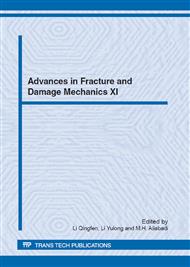p.333
p.337
p.341
p.345
p.349
p.353
p.357
p.361
p.365
Influence of Welding Conditions on Residual Stresses of Multi-Pass Tube Sheet Welds
Abstract:
Residual stresses and residual plastic strains of the welded structures are the products of nonlinear behaviors during welding. The residual stresses will cause errors during the assembly of the structure and injure the beauty of appearance of the structure. Based on an elastic-plastic-model, finite element numerical simulation of a representative tube sheet penetration assembly with loop welding line joined by multi-pass welding is carried out and the influence of welding conditions on residual stresses of the tube sheet welds is studied in this paper. Nonlinear three dimensional transient temperature fields and real-time dynamic stresses field are analyzed by FEM. The heat source is modeled as a moving heat flux following a double ellipsoid distribution and the temperature-dependent properties of materials are considered. The method of birth and death of element in finite element analysis is applied to simulate the gradual growth of weld pass metal. It is shown that welding sequence, size of groove welding and weld toes dressing will obviously change the magnitude of the residual stresses of tube sheet welds.
Info:
Periodical:
Pages:
349-352
Citation:
Online since:
November 2012
Authors:
Price:
Сopyright:
© 2013 Trans Tech Publications Ltd. All Rights Reserved
Share:
Citation:


